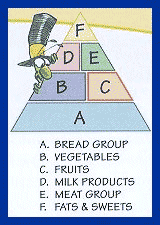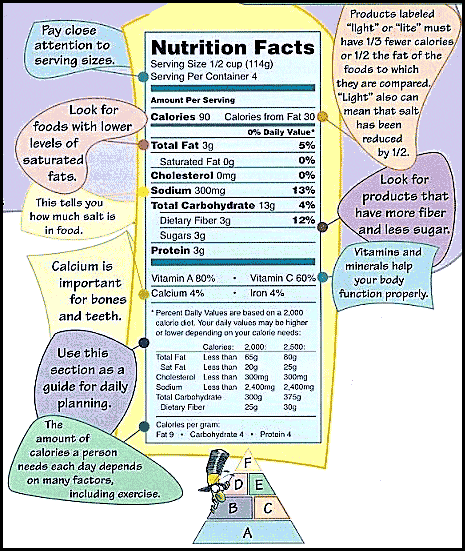National Institute of
Environmental Health Sciences


NIEHS Kids' Pages Index!
Links Disclaimer
Privacy Policy and Disclaimers
National Institute of |
 NIEHS Kids' Pages Index! Links Disclaimer Privacy Policy and Disclaimers |
Food Labels Tell the Story!From the Label to the Table! |

|
Food provides your body with all of the materials it needs to grow, and to be healthy and active. These are some of the building blocks in food.
CARBOHYDRATES are the body's main source of fuel. Starchy foods like breads, spaghetti, rice, potatoes, corn and cereals are made up mostly of carbohydrates. Sugary foods like candy, jam and syrups also are carbohydrates. Some carbohydrates, called fiber or roughage, are hard to digest. They help move waste through the digestive system.
FATS include butter, margarine, lard, shortening, and cooking oil. Cheese, cream, chocolate, some meats and many desserts have a lot of fat. Fats are very concentrated sources of energy, so only a little is needed.
PROTEINS, are important for growth and repair of the body. Protein-rich foods include eggs, milk products, meat, dried beans, chicken, turkey, and fish. The body also can use protein as fuel for movement and growth.
MINERALS are found in small amounts in foods. They are needed for many of the body's functions. For example, calcium is used to build bones and teeth, and also is important for muscles and the nervous system. Iron becomes part of red blood cells.
VITAMINS are other chemicals found naturally in food. They are needed in very small amounts by the body.
Did you know that WATER also is a major part of almost all food?
| Make a food diary for each member of your family. Have places to record the foods eaten and approximate amounts. This is where estimation skills come in handy! Ask each person to complete the diary over the course of a day. Compare the finished food diaries with the food pyramid. Did each person get what they need from every group? How did you do? What recommendations can you make? Eating a healthy diet doesn't mean giving up your favorite foods. Just balance your food choices and eat smaller amounts of the richer foods at the top of the pyramid. |  Text version of above graphic |
Beginning in 1994, the US government began requiring manufacturers to put information about nutritional value on food labels. You can use this information to make better choices about what you eat -- watch for the following information:

| My Health My World Explorations for Children and Adults is a publication of the Division of School-Based Programs, Department of Family and Community Medicine, Baylor College of Medicine , and was made possible by a grant from the National Institute of Environmental Health Sciences. For more information, contact Center for Educational Outreach, Baylor College of Medicine, Houston, TX. Thanks to Baylor for allowing NIEHS to reproduce portions of those articles here on the NIEHS Kids' Pages! |

| Links Disclaimer and Caution |
|---|
When you encounter this image or the words "Non-NIEHS Link", it means that by following that link you will be leaving the NIEHS website. NIEHS is NOT responsible for non-NIEHS websites. Sites maintained by outside organizations may be changed without notice to NIEHS. Therefore, unless the link is to another U.S. government sponsored webpage, endorsement by NIEHS is not implied, and NIEHS does not guarantee their continuing safe content or privacy policies. So please ask your parent or guardian before continuing to any non-NIEHS website, and especially before providing any information via the internet or by e-mail. When last reviewed, the websites linked from the NIEHS Kids' Pages seemed suitable for you to visit, but that may have changed; if you have any difficulties or concerns with any linked materials, please let us know . or the words "Non-NIEHS Link", it means that by following that link you will be leaving the NIEHS website. NIEHS is NOT responsible for non-NIEHS websites. Sites maintained by outside organizations may be changed without notice to NIEHS. Therefore, unless the link is to another U.S. government sponsored webpage, endorsement by NIEHS is not implied, and NIEHS does not guarantee their continuing safe content or privacy policies. So please ask your parent or guardian before continuing to any non-NIEHS website, and especially before providing any information via the internet or by e-mail. When last reviewed, the websites linked from the NIEHS Kids' Pages seemed suitable for you to visit, but that may have changed; if you have any difficulties or concerns with any linked materials, please let us know .
|